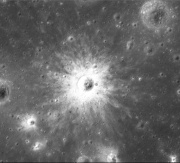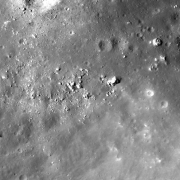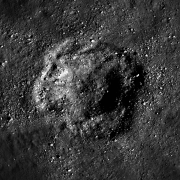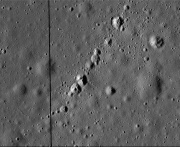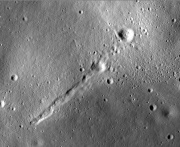The following guide is designed to accompany Moon Mappers: Simply Craters and Moon Mappers: Man vs Machine.
There are many, many different types of features on planetary surfaces such as the moon, though many of them are variations on themes. They generally fall into a few kinds of feature classes: Craters, volcanic, linear (can be tectonic or volcanic), and a broad “other.” All of these are interesting in their own way and we want you to help us find them.
Light Albedo Feature
When craters are formed, the impact scatters about the crater a blanket of bright material. Called an ejecta deposit, it is made of pulverized material. This ejecta appears very bright when first formed, but slowly fades as it ages due to interactions with micrometeorites and the radiation of space. When you see craters with bright ejecta and bright rays, you are seeing some of the youngest features on the moon. It’s thought the oldest light ejecta blankets are 1 billion years old – which is yesterday in geology. Studying young craters is an important part of lunar science, but to do that, we need to know where they are!
Dark Albedo Feature
Dark features can come from either volcanic eruptions, or more commonly through special, impact craters. Just like the Earth’s surface is made of many layers of soil (top soil, clays, bedrock, etc) the Moon’s surface is also made of multiple layers, which happen to have different colors. Sometimes an impact event that forms a crater punches through the top, light-colored layer and excavates a darker layer from underneath. When this happens, the dark colored material gets thrown into the air and falls to the Moon’s surface to form a crater ejecta. This material appears dark in contrast to the surrounding surface.
Boulders
Boulder fields are strewn across the lunar surface, but they are highly non-uniform. Sometimes we find them at the bottom of craters, sometimes on crater walls. Other times strewn around the rims of large craters. We can also often find evidence of rolling boulders because they will leave a trail in the lunar dust.
And yet, there are many craters that don’t seem to have any boulders in or near them whatsoever. With the incredible resolution of the Lunar Reconnaissance Orbiter’s Narrow Angle Camera (roughly 50 cm/pix scale), we can actually see individual boulders that are the size of a medium dog. Help us figure out where they are by marking them with this option!
Concentric Craters
Sometimes craters look like there is one crater nested just inside a slightly larger crater. This is not a freak accident, where one crater impacted just inside another one (though that does occur, but very very rarely). Scientists think these craters form when the region impacted consists of two layers of very different material; a weak rubble (or regolith) layer on top of a harder rock layer. The weak layer is more easily ejected by the impact than the hard layer, forming a slightly larger crater in the regolith than in the rock below. These craters allow us to understand the depth of different layers of material in different regions of the moon.
Crater Chains
One of the most intriguing types of feature on the moon is the crater chain. These streaks of craters can be formed through three types of events: a broken object hitting the moon, material scattered during a “primary” impact event, and volcanoes.
Sometimes, when a large crater is formed, the impact can hurl large blocks of material (ejecta) that land in a row. This forms chains of craters that we call “secondary craters” (since they formed as a result of the main, primary crater). If you see a bunch of craters in a row, the most common explanation is that they formed from these secondary impacts.
In some, much rarer cases, crater chains can also form when a string of broken up asteroid or comet pieces hits the Moon. Gravitational disruptions and impacts between objects can sometimes break up comets and asteroids. These broken up pieces may continue along the same orbital path, but spread out as they travel. When these strings of rock or ice hit an object like the moon the can form crater chains.
The moon also has its own ability to create objects that look like crater chains, but actually aren’t! (We don’t expect you to tell the difference.) These chameleons are actually volcanic in origin. They are made when the magma chamber inside a volcano collapses, forming individual depressions and chains of pits, much like volcanoes here on Earth. Occasionally, things that look like crater chains can also form when a volcanic lava tube collapses in sections along the tube.
Odd Shaped Feature
What to do if you see something that looks weirdly shaped and you don’t know what it is? Or, you know what it is but we don’t have a specific selection option for it, say, an elliptical crater. Use this classification.
Odd Albedo Feature
If you see a feature that doesn’t seem to have any three-dimensionality to it but is rather a bright or dark splotch, select this option. We never know what we might find! One unusual feature on the Moon is Lunar swirls, like the one pictured at right. This feature, on Mare Ingenii, is being considered for future space exploration. These colorful regions are created by magnetic fields that are thought to shield part of the surface from weathering. These lunar swirls have been known for 100s of years, but as we look at more and more of the Moon in higher and higher resolution we may discover other other unusual albedo features we can’t yet imagine.
Unknown
We may not have a pull-down item for something that you see. You may not know at all what you see other than it’s weird – you can’t tell if it’s light or dark, there’s a topography difference, or anything else. Use this option if all else fails.

